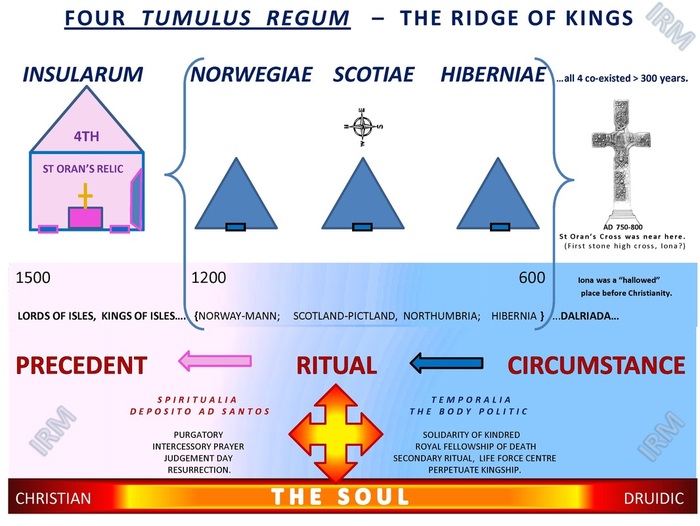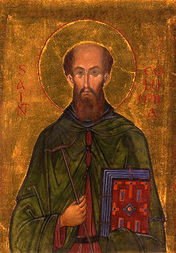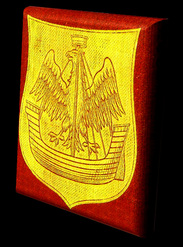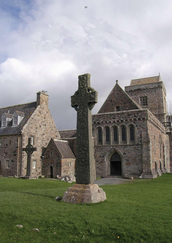THIS IS WHY THE KINGS AND LORDS OF THE ISLES ARE BURIED IN RÈILIG ODHRAIN
- NOT THE ABBEY CHURCH -
[and not Saddell]
1549 : “This sanctuary was wont to be the sepelture of the best men of the Isles, and also of our Kings, as we have said;
because it was the most honorable and ancient place that was in Scotland in those days, as we read”.
[ "Description of the Occidental, ie, Western Isles of Scotland"; Donald Monro; 1549.]
“This was the grand cemetery of Iona,
the cherished and far-famed spot whither,
for ages, funeral parties voyaged
from a distance to inter the illustrious dead.”
- NOT THE ABBEY CHURCH -
[and not Saddell]
1549 : “This sanctuary was wont to be the sepelture of the best men of the Isles, and also of our Kings, as we have said;
because it was the most honorable and ancient place that was in Scotland in those days, as we read”.
[ "Description of the Occidental, ie, Western Isles of Scotland"; Donald Monro; 1549.]
“This was the grand cemetery of Iona,
the cherished and far-famed spot whither,
for ages, funeral parties voyaged
from a distance to inter the illustrious dead.”
|
.........as per below embedded Scribd doc.
SOMERLED mac Gillibhride: k.1164 - REX INSULARUM, BURIED IN HIS OWN SUPERIOR CHAPEL, TEMPEULL ODHRAIN, SYMBOLISING THE 4TH TOMAIRE NAN RIGH, TUMULUS REGUM INSULARUM. “THE MOST HALLOWED SPOT ON IONA.” | ||||||
Your browser does not support viewing this document. Click here to download the document.
Above : Somerled built and was buried, 1164, in his new, mid 12th C. mausoleum, Reilig Odhrain, ie, St Oran’s Chapel. Historic Scotland date the chapel as c.1150 matching Somerled’s conquest of the Isles. Reginald was only born c.1153 (died age 54 – G. Buchanan) therefore he could not have built it. As RI INNSE-GALL (King of The Isles) Somerled would demand nothing less than to be buried with the 40 (at least) other Gaelic/Celtic/Pict/Norse Kings (or ‘sub-kings’) of Ireland, Scotland and ‘Norway’ in Reilig Odhrain, the most ancient graveyard in all Scotland -“The Royal Fellowship of Death” .
“REPORT OF 20 WRITERS IN ICOLLUMKILL”:- “With regal pomp and ceremony the body of the King of the Isles was buried ……in Iona’s piles, where rest from mortal toil the mighty of the Isles." (Hugh of Sleat, c.1650). “A sepulchre on Iona was Somerled’s final right.” “His body was taken to Iona; his place of sepulture was the ancient ecclesiastical capital of his island domains.” [ The Death and Burial of Somerled of Argyll, West Highland Notes and Queries, ser. 2, no.8, Nov.1991, p.6-10. McDonald, Russell Andrew.]
This photo (above) probably by the Iona Club just after finishing the re-arrangement of slabs in the cemetery (c.1858) and in St Oran’s Chapel and then gating it shut (c.1860- see the thin iron pickets). It is not a good quality image (even enhanced) but a very good one to add text and graphics to which clearly show the historical context (The chapel restored and re-roofed a century later in 1957 by the Iona Community).
“REPORT OF 20 WRITERS IN ICOLLUMKILL”:- “With regal pomp and ceremony the body of the King of the Isles was buried ……in Iona’s piles, where rest from mortal toil the mighty of the Isles." (Hugh of Sleat, c.1650). “A sepulchre on Iona was Somerled’s final right.” “His body was taken to Iona; his place of sepulture was the ancient ecclesiastical capital of his island domains.” [ The Death and Burial of Somerled of Argyll, West Highland Notes and Queries, ser. 2, no.8, Nov.1991, p.6-10. McDonald, Russell Andrew.]
This photo (above) probably by the Iona Club just after finishing the re-arrangement of slabs in the cemetery (c.1858) and in St Oran’s Chapel and then gating it shut (c.1860- see the thin iron pickets). It is not a good quality image (even enhanced) but a very good one to add text and graphics to which clearly show the historical context (The chapel restored and re-roofed a century later in 1957 by the Iona Community).
|
Were these three insignificant dry stone buildings (tumulus regum) originally elongated monk’s cells in what was St Oran’s first small monastic enclosure? (“not above 10 feet long and 5 feet broad, within”; Rev J. Walker in 1764.) They almost match in size, shape and construction the “very primitive looking” structure on Eilean Mor, one of the wild Flannian Isles (west of Lewis) - called the chapel of St Flann or Teampull Beannachadh [1].
[1] “within, the dimensions are - length 7’ 3”; width, 4’ 5”). The Ecclesiastical Architecture of Scotland, VOL I; p.77-78. David MacGibbon and Thomas Ross; 1897. |
Reilig Odhrain was a hallowed place long before the coming of firstly St Oran (d.548, Iona) and then St Columba’s arrival in AD 563. It was anciently known to the Gael as I (later written Hi; pronounced ‘Ee’) , ‘THE Island – par excellence’.
An island correctly identified in pre-history by the resident Priests of Innis nan Druidheanach (Isle of Druids) as made of (some of) the oldest rock in the world and destined to be the last place destroyed at world’s end (Carmina Gadelica – rune lore). Where else would a King want to be buried to await the Day of Doom? |
| st_orans_outside_cemetery_weebly..pdf | |
| File Size: | 917 kb |
| File Type: | |
Your browser does not support viewing this document. Click here to download the document.
"Isle of sleep, where dreams are holy,
Sails to thee a King who sleepeth,
With thy Saints we leave him sleeping”.
(Iona Boat Song.)
Sails to thee a King who sleepeth,
With thy Saints we leave him sleeping”.
(Iona Boat Song.)






